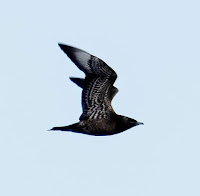OK, so the scenes been set. Birding in 2020 was tough. I had only two life birds, from out of state for the year. Then the Booby showed up in Ohio, which was crazy --- then a Parasitic Jaeger at an inland reservoir, so I'm up to +4 life birds now, when what do you know . . . eleven days later during fall sparrow migration . . .
 |
| What's that?? |
 |
| Wait for movement . . shh |
Distinctively orange-buff all over, particularly on the head and upper breast. It has black streaks on the back and wings and a grayish-purple spot on the back of the neck. The belly is white. The bill is gray.
Walks or hops on the ground, often among dense grasses. Does not flush readily, and prefers to escape from disturbances on foot. When they do fly, their flights are short, with quick, weak wingbeats before disappearing back into the vegetation
Open habitat, especially marshy or boggy meadows with a dense cover of grasses or sedges.
 |
| LeContes Sparrow . . . #626 |
The LeConte's sparrow was discovered by John James Audubon, and it was thought that he named this bird after a friend, Doctor LeConte. It is generally believed that he meant John Lawrence LeConte, although some feel that he was referring to another John LeConte, also a doctor, and John Lawrence's cousin.
The LeConte's is becoming more of a regular fall migrate here in Ohio. All these years ago, both Nelson and LeContes didn't come this far east. The Nelsons was more east coast, and the LeContes was more Illinois in the fall and Minnesota in the summer. Then within the last 10 years, both species have become way more frequent each year. In Ohio, for the LeContes, you would have to go up to Mentor county, off the lake, on Wake Robin trail/marsh, and only for 1-3 days, when the sparrows would move in off the lake, rest, eat, and boom move on farther south.
So in the last 9 years, I'm happy to finally see both LeContes and Nelsons sparrows here in Ohio
Video History
Gambill Family history:
Buddy--April 1980 Aranasas, Texas coast
Red&Louise--seen not sure when. Notes Nelson sparrow split w Seaside Sparrow in 1996.
 |
| COVID-19 Life Birding!! |
 |
| ducks, lots of ducks |




































